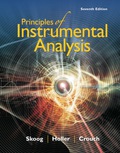
Concept explainers
(a)
Interpretation:
The materials as well as instrument components required for making an instrument used to investigate the absorption bands in the given range of wavelength.
Concept introduction:
Spectral lines help in identifying the atoms and molecules. These are result of absorption or emission of light in a comparatively narrower frequency range compared to the frequencies nearby.
(b)
Interpretation:
The materials as well as instrument components required for making an instrument used to obtain the absorption spectra in far IR − 20 to 50 µm needs to be suggested.
Concept introduction:
Spectral lines help in identifying the atoms and molecules. These are result of absorption or emission of light in a comparatively narrower frequency range compared to the frequencies nearby.
Spectral region consists of different wavelengths which are distinguished based on the sources used to produce them and detect the different wavelengths.
(c)
Interpretation:
The materials as well as instrument components required for making an instrument used to make a portable device to determine the iron content in natural water depending on absorption of radiation by red Fe(SCN)2+ complex needs to be suggested.
Concept introduction:
Spectral lines are lines which help in identifying the atoms and molecules. These are a result of absorption or emission of light in a comparatively narrower frequency range compared to the frequencies nearby.
Spectral region consists of different wavelengths which are distinguished based on the sources used to produce them and detect the different wavelengths.
(d)
Interpretation:
The materials as well as instrument components required for determination of nitrobenzene in air samples depending on absorption peak at 11.8µm needs to be suggested.
Concept introduction:
Spectral lines are lines which help in identifying the atoms and molecules. These are a result of absorption or emission of light in a comparatively narrower frequency range compared to the frequencies nearby.
Spectral region consists of different wavelengths which are distinguished based on the sources used to produce them and detect the different wavelengths.
(e)
Interpretation:
The materials as well as instrument components required for making an instrument used to determine the wavelength of flame emission lines for metallic elements in 200 nm to 780 nm region needs to be suggested.
Concept introduction:
Spectral lines are lines which help in identifying the atoms and molecules. These are a result of absorption or emission of light in a comparatively narrower frequency range compared to the frequencies nearby.
Spectral region consists of different wavelengths which are distinguished based on the sources used to produce them and detect the different wavelengths.
(f)
Interpretation:
The materials as well as instrument components required for making an instrument used for spectroscopic studies in vacuum UV region needs to be suggested.
Concept introduction:
Spectral lines are lines which help in identifying the atoms and molecules. These are a result of absorption or emission of light in a comparatively narrower frequency range compared to the frequencies nearby.
Spectral region consists of different wavelengths which are distinguished based on the sources used to produce them and detect the different wavelengths.
(g)
Interpretation:
The materials as well as instrument components required for making an instrument used for spectroscopic studies in the near IR region needs to be suggested.
Concept introduction:
Spectral lines are lines which help in identifying the atoms and molecules. These are a result of absorption or emission of light in a comparatively narrower frequency range compared to the frequencies nearby.
Spectral region consists of different wavelengths which are distinguished based on the sources used to produce them and detect the different wavelengths.
Trending nowThis is a popular solution!

Chapter 7 Solutions
Principles of Instrumental Analysis
- Pls help.arrow_forward16) A 2.0 L flask containing 2.0 x 10-3 mol H2(g), 3.0 x 10-3 mol Cl2(g), and 4.0 x 10-3 mol HCl(g) at equilibrium. This system is represented by the following chemical equation: H2 (g) + Cl2 (g) → 2HCl(g) Calculate the equilibrium constant for this reaction.arrow_forward7) The pH of a 0.05M solution of HCl(aq) at 25°C is a. 1.3 b. 2.3 c. 3.3 d. 12.7arrow_forward
- 11) The Ksp expression for copper (II) sulfate is: a. [Cu2+][SO4²¯] b. [Cu²+]² [SO4²]² c. [Cu²+]²[SO4²] d. [CuSO4] 12) Which of the following is true about a chemical system in equilibrium? a. All chemical reactions have stopped b. The concentration of reactants is equal to the concertation of products c. The forward and reverse reaction rates become equal d. The system will remain at equilibrium regardless of any external factorsarrow_forward21) Explain the difference between the rate of a reaction and the extent of a reaction. Why are both of these concepts important, if you are a chemical engineer that is trying to develop a process to produce a large volume of a specific type of chemical compound?arrow_forwardPls help.arrow_forward
 Principles of Instrumental AnalysisChemistryISBN:9781305577213Author:Douglas A. Skoog, F. James Holler, Stanley R. CrouchPublisher:Cengage Learning
Principles of Instrumental AnalysisChemistryISBN:9781305577213Author:Douglas A. Skoog, F. James Holler, Stanley R. CrouchPublisher:Cengage Learning
